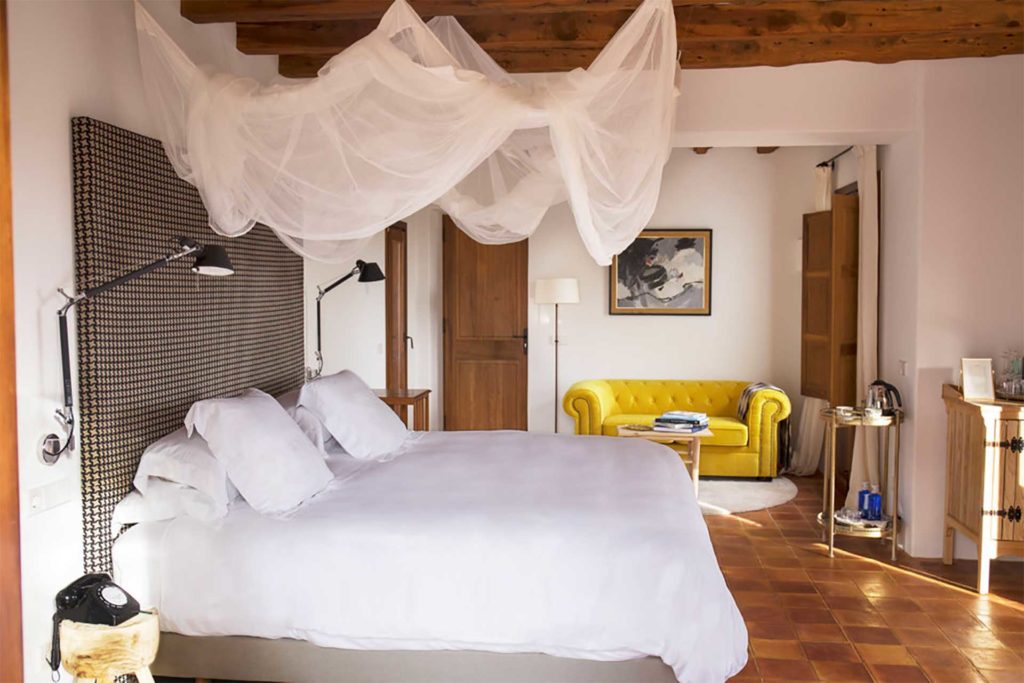Published on 12 June 2015 in Cosas de Comé by Pepe Monforte. Images courtesy of Aponiente.
Restaurant Aponiente Puerto Santa Maria
Angel León, known as Chef del Mar (Chef of the Sea), has set his new restaurant in El Puerto de Santa Maria on 1 September 2015. León has two Michelin stars for his current offering, Aponiente, in El Puerto, the seaside sherry town across the bay from Cadiz. The new gourmet establishment houses in an 18th-century flour mill next to the salt marshes. The project includes a restaurant and a gastronomic laboratory for developing new products, in collaboration with local Cadiz companies. His former restaurant, in calle Puerto Escondido, is now a tapas bar.

Made of piedra ostionera (oyster sandstone), the same material used to build Seville’s vast cathedral, the building brings to mind a boat. Covering 1780m2 over two floors, the mill is built on arches with water flowing underneath – situated in the middle of a riverbed, it seems to be floating on the water. This water moved the mill, which ground the wheat to make flour. The tide mill, situated next to El Puerto de Santa Maria train station, was the first of its kind to be built in the city and started working in 1819, around the same time as the railway. This beautiful and historic building is constructed over a small tributary of the Guadalete estuary, in the Bahía de Cádiz Natural Park. Angel León, the Cadiz chef who is taking his marine cuisine to the world’s gastronomic elite, says that his restaurant “could not talk about the sea without being able to see its waters”. Which is why he has spent several years looking for his dream location, checking out salt and marsh houses to find the definitive home for Aponiente: “It was the only way to stay in the Cadiz area, because in our former premises, we didn’t have space to develop”. Aponiente was the only two-Michelin-starred restaurant of such a diminutive size without a car park, a good-sized wine store or one of those toilets where you feel guilty having a pee because they’re so luxurious. However, the unique nature of his cooking and the revolutionary gastronomic paths pioneered by the “Chef del Mar” allowed him to be awarded the accolade. The tide caught Angel León when he discovered this old mill, which had been renovated by the state in 2011 and then handed over to El Puerto de Santa Maria town hall. The chef explained his project to the administration, which ran a public competition to adjudicate the building’s development. León was the sole entrant in the competition, so he was allowed to lease the mill for a 30-year period.
More than just a restaurant
The chef-restaurateur has ambitious plans for the new premises, where 37 people are employed. Rather than being simply a restaurant, it is a site of gastronomic research, carried out in collaboration with universities and private companies, preferably local ones. Leon’s idea is that projects are presented to him, he chooses the most interesting ones, and then he and his team are involved in their development. In addition the tide mill will host exhibitions and meetings, as well as school visits, with everything themed around gastronomy and the sea. The gastronomic laboratory is situated on the second floor of the building, while the ground floor is largely taken up by the restaurant itself. This is reached by a long, wide passageway where diners start to enjoy the spectacle – two of the fundamental characteristics of the new premises are transparency and spectacle.
Aponiente is now a site of gastronomic research, carried out in collaboration with universities and private companies
Visitors are able to see the chefs working through large glass windows. Eating is not simply a case of sitting down at a table: “In fact, you won’t just eat at the table,” states Leon. Nevertheless, the cuisine is the same as is served at the old location Puerto Escondido – in other words, two tasting menus, one with more dishes than the other, both dedicated entirely to marine ingredients. When you first come into the new Aponiente, you find yourself in an impressive reception area. From here, you can see seven-metre-high walls made of oyster sandstone, and a pitched roof held up by wooden beams. One of the most striking characteristics of the new Aponiente is that Leon has used exclusively local companies. 
The project architect is Basilio Iglesias Lobatón, from Bia Architects, based in El Puerto de Santa María, which already has experience in building restaurants. Its most impressive project is the visitors’ reception area of Bodegas González Byass Winery in Jerez, using innovative materials, while respecting the famous dome of the spacious winery. In the visitors’ reception you can see a saltmarsh landscape, situated on top of the various spaces which look like they’re built from salt. Underneath them you can find the restaurant’s wine store, a bread-baking area – the restaurant will make its own bread; an area dedicated to preparing fish and seafood, which will look like a traditional fishmonger’s shop; and finally, the actual kitchen. These four spaces will be located either side of the three-metre-wide passageway along which clients will walk, while being told about what goes on in each area.
Everything on view
The main feature of these four spaces is that they all boast large glass windows so that visitors can see inside the wine store, and how the cooks work in the bakery, the fish preparation area, and the kitchen. Angel León points out that “We’ve given the bakery a leading role because this was a flour mill. They ground the flour which was used to make bread for the whole city at the beginning of the 19th century“. In fact, one of the original millstones will be displayed in the entrance. The restaurant already makes its own bread, but now this task will take on a more important role and will become a showpiece for clients. The winery will be another of the main attractions: the Maitre d’, Juan Ruiz Henestrosa, recently awarded Best Sommellier of the Year by the International Academy of Gastronomy, will operate from there. León wants this space to become a benchmark for Jerez wines, due to Ruiz Henestrosa’s excellent knowledge. In its new incarnation, Aponiente is especially keen to use Vinos de la Tierra (good quality registered local wines).
Made-to-measure kitchen
The third stop will be the fish area. Here visitors will be able to see how fish and seafood are prepared, to be eaten later in the restaurant. The kitchen and the machinery room, will also be visible to the public, who will be able to watch from the dining room, situated at the end of the building and with various windows and balconies overlooking the salt marshes. The kitchen equipment is being supplied by another local company, Unic of El Puerto de Santa Maria. All the machinery is currently being produced in Switzerland by Electrolux Professional, which is making the kitchen “to measure” for the restaurant.
An experience unique to its location
 But where León is most deeply involved is in the restaurant itself. The chef offers some clues as to where things are headed in the future. “Above the dining room there is a terrace with amazing views. We will also be making the most of this and at some point during the meal, this area will take a leading role. Not this season, but we will want dining at Aponiente to be an experience which is about more than just eating. Food doesn’t need to happen in one space only and the diner can interact too, take part in the action somehow. In September we’ll have made a start, but then we want to prepare it completely for the 2016 season with plenty of surprises – at that point, you’ll be able to see more clearly what our plans are for the new Aponiente. We want people to come here, to Cádiz, to have a unique experience, which they couldn’t have in any other part of the world”. All the infrastructure of the dining room is being made especially for the restaurant, right down to the chairs and plates. The former, for example, will have striking aluminium legs and their backs will be covered with leather from Ubrique, in blue. They will look like the tail of an estuary mullet and are designed to envelop the client.
But where León is most deeply involved is in the restaurant itself. The chef offers some clues as to where things are headed in the future. “Above the dining room there is a terrace with amazing views. We will also be making the most of this and at some point during the meal, this area will take a leading role. Not this season, but we will want dining at Aponiente to be an experience which is about more than just eating. Food doesn’t need to happen in one space only and the diner can interact too, take part in the action somehow. In September we’ll have made a start, but then we want to prepare it completely for the 2016 season with plenty of surprises – at that point, you’ll be able to see more clearly what our plans are for the new Aponiente. We want people to come here, to Cádiz, to have a unique experience, which they couldn’t have in any other part of the world”. All the infrastructure of the dining room is being made especially for the restaurant, right down to the chairs and plates. The former, for example, will have striking aluminium legs and their backs will be covered with leather from Ubrique, in blue. They will look like the tail of an estuary mullet and are designed to envelop the client.
“We want people to come here, to Cádiz, to have a unique experience, which they couldn’t have in any other part of the world”, says Ángel León
Ángel León himself has overseen the design of the “scene” where he shows off his gastronomic creations, along with his friend, the sculptor Javier Ayarza. They have worked together, with the Spanish singer Clara Monte, on the “sea of emotions” project, a joint show of music, small sculptures and cuisine, which develops all three to emphasize the recovery of the sea. The sculptor has designed plates made of oyster sandstone and other materials which serve to show off the chef’s edible “jewels”. Ayarza created the lamps and other decorative elements of the dining room, which are all “a homage to the sea”. The lights, for examples, are in the shape of micro-algae.
The current Aponiente in calle Puerto Escondido is now a disruptive tapas bar
The former restaurant, in calle Puerto Escondido, will not close. It has been turned into a seaside taberna of “tapas canallas”, says Angel León. The term canalla (daring), very in-vogue among chefs, means that it will be an informal space, with a gamberro (rough and ready) edge; a fun and relaxed concept. The chef’s idea is to serve his cuisine in a different way, with different prices. Having tapas costs around 20 to 30 euros “which everyone can afford. That way all the public can eat my food. It’s something I am really keen to do”. Are you going to miss it?















